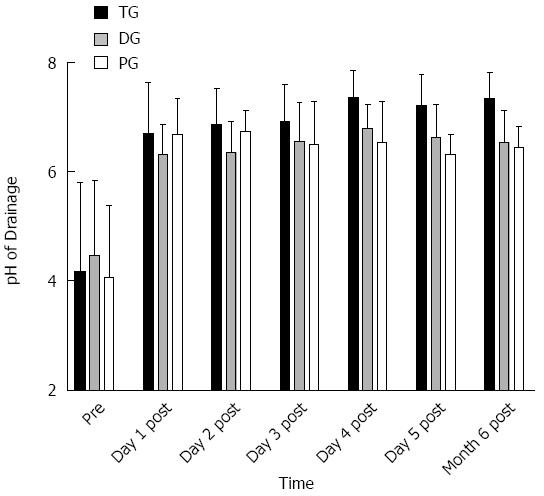Copyright
©2014 Baishideng Publishing Group Inc.
World J Gastroenterol. Jun 14, 2014; 20(22): 6981-6988
Published online Jun 14, 2014. doi: 10.3748/wjg.v20.i22.6981
Published online Jun 14, 2014. doi: 10.3748/wjg.v20.i22.6981
Figure 1 Gastric pH of patients undergoing total, distal and proximal gastrectomy.
Pre-surgical pH was all very significantly larger than 3.5, the threshold value of hypoacidity (P < 0.01). No significant difference in pre-operative pH was observable between the 3 groups (P > 0.05). Gastric pH on the 1st to the 5th days and 6 mo post-surgery in the 3 groups was all very significantly larger than that pre-operation and 4, the threshold pH of weak-acid reflux (P < 0.01). On the 1st day post-gastrectomy, gastric pH was comparable among the 3 groups (P > 0.05). On the 2nd day, both the total gastrectomy (TG) and proximal gastrectomy (PG) groups were accompanied with significantly higher gastric pH than the distal gastrectomy (DG) group (P < 0.01), while there was not significant difference between the TG and PG groups (P > 0.05). On days 3, 4 and 5 and 6 mo post-gastrectomy, patients undergoing TG had significantly higher gastric pH than both individuals receiving DG and those undergoing PG (P < 0.05), while the difference between the DG and PG groups was insignificant (P > 0.05). There were no significant differences between gastric pH on the 3rd, 4th, and 5th days and 6 mo post gastrectomy in all groups (P > 0.05).
- Citation: Huang L, Xu AM, Li TJ, Han WX, Xu J. Should peri-gastrectomy gastric acidity be our focus among gastric cancer patients? World J Gastroenterol 2014; 20(22): 6981-6988
- URL: https://www.wjgnet.com/1007-9327/full/v20/i22/6981.htm
- DOI: https://dx.doi.org/10.3748/wjg.v20.i22.6981









